Through the lens of the camera: Using photos to understand why safe disposal matters to community members

The Haz Waste Program used Photovoice to better understand how people engage with and prioritize environmental health and stewardship. Community partners were given a series of research questions and instructed to respond by taking photographs.
Haz Waste staff and community members then met to do a “gallery walk” of the images collected, with captions written by each participant to describe the photos they took. Photos included images of polluted streams, oil leaks under cars, community centers, and neighborhood parks. Afterward, community partners talked about the photos they’d seen and how each resonated with them.
“Sometimes research prioritizes rigor and big datasets over depth and community relationships. This project was unique because it used a creative, arts-based framework to ask the community about their needs and wants,” explained Dr. Roger Chin, epidemiologist and lead researcher for the study. “Community partners were asked to keep a photo journal. It gave us an opportunity to hear from the community in their own words and through their lived experiences.”
The resulting dialogue prompted conversation about the connection between hazardous waste and food systems. Community members shared stories about how hazardous products have impacted their health and their family members.
“I have a community garden plot in the Ballard P-Patch and it’s yet another space that I go to connect with my environment more intimately. I can get my hands in the dirt and chat with my fellow gardeners, sometimes learning new gossip that reminds me how interconnected we all are,” wrote one community partner in the caption of one of their photos.
The findings from this research will help inform how the Haz Waste Program communicates and connects to residents about the importance of hazardous waste management.
Understanding, for instance, that people care about protecting our food systems can help us connect responsible battery disposal, or choosing greener cleaning products, to protecting our waterways and keeping our soil free of contaminants.
The Haz Waste Program hopes to build on these learnings with continued community engagement. Our communities and residents are the greatest stewards of our land, and partnering with them helps us keep our backyard healthy, vibrant, and thriving.
To learn more about this research study and its findings, read the full report here.

 Translate
Translate